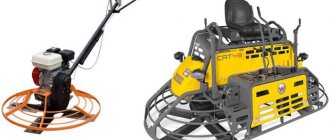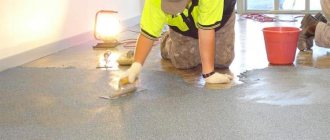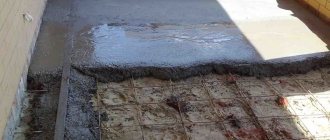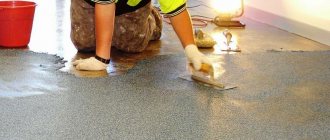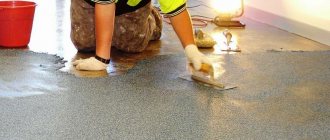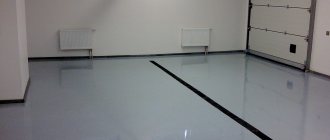Concrete floors are characterized by high strength, durability, unpretentiousness, and an affordable price. But at the same time they also have weaknesses. The most obvious of them is the tendency to destroy the top layer. Over time, cracks, potholes and chips appear on the surface of a concrete floor. To prevent this process, various concrete strengthening technologies are used.
The main thing about the rule: what is it and why?
The rule is a narrow, even ruler with no flaws. The use of the tool allows you to complete the work of forming a rough but even concrete plane without construction errors. The scope of application extends to working with plaster, concrete, laying tiles, installing ceilings, screeds.
Varieties
There are two types:
- metal;
- wooden.
To level the concrete surface, it is recommended to use a trowel made of metal.
Externally, these types of instruments are absolutely identical. For practicality, it is better to use metal ones. This is due to the fact that wood tends to absorb moisture, and this leads to deformation of the surface of the guide, and the evenness of the shape is lost. Aluminum rules are more common in manufacturing. This metal is lightweight, does not rust, and has a long service life. Minor repair work involving concrete can be easily handled with a simple plastering rule.
Correct choice
The technical requirements for the plane before starting finishing work are quite high. The verticality and horizontality of the surface is determined by the bubble building level built into the slats
When choosing, you should pay attention to its availability. To protect the internal profile from the penetration of external pollutants, special tips (plugs) are used.
Stiffening ribs provide protection against potholes in the event of a fall. Their presence directly affects the operational period. It is necessary to have an external semicircular groove and internal ribs on the surface of the guide. The homemade rule for concrete works effectively if it is made short and not heavy.
How to use?
The tool moves in translational movements from one side to the other, reaching a rough, flat concrete surface. Free movement along pre-placed beacons can be achieved on all types of surfaces: vertical, horizontal, inclined. It is also possible to work without beacons, but without experience it will be more difficult. When performing work, attentiveness and accuracy are required.
Benefits of strengthening with topping
The technology of strengthening concrete floors with the help of special dry mixtures (toppings) has proven itself when used at various facilities, and therefore is now very popular. Topping can be used to strengthen a concrete surface, which will be used independently in the future, or to strengthen the base for any other floor covering. This technology involves applying a special dry mixture to freshly poured concrete and then grouting it using a trowel. The smoothing blades of this machine press the topping into the hardening concrete. In this case, a hardened surface layer is formed.
Concrete floors, after strengthening with topping, acquire the following advantages:
- high strength. After topping, concrete grade M400 acquires strength equal to grade M800;
- the strengthened surface acquires better performance characteristics, and its maintenance becomes easier;
- concrete floors with topping stop generating dust and become highly resistant to abrasives;
- treated concrete acquires antistatic properties;
- With the help of topping, you can improve the decorative effect of a concrete floor, giving it a variety of textures: grainy, smooth, mirror-like.
The main technical parameters of floors with topping are determined by the components of the rubbed mixture. This mixture contains cement, mineral pigments and fillers.
The size of the filler fractions is selected depending on the type of concrete used to fill the floor. When choosing, you must remember that any fine filler has the least adhesion to the concrete base, so the likelihood of such topping peeling off is much higher.
The use of a larger fraction gives the floor increased strength, but greatly reduces the ductility of the mixture.
Depending on the type of filler, mixtures are divided into:
- quartz;
- corundum;
- metallized.
Quartz mixtures
The operational and technical properties of quartz hardeners allow them to be used for floors subject to moderate wear loads. Quartz toppings are used to strengthen floors in shops, administrative buildings, warehouses and garages with low loads.
The use of quartz sand as a filler can increase the strength of a concrete floor by one and a half times. The main advantage of quartz topping is its affordable price.
Corundum topping
Corundum hardeners are used when it is necessary to create a particularly stable concrete floor subject to high loads. Floors reinforced with a corundum mixture can be subjected to increased abrasive and impact loads every day, but cracks and other damage will still not appear on them.
Corundum chips, used as one of the components of the strengthening mixture, give the floors special strength. With the help of corundum topping, the strength of a concrete floor can be increased by 1.7 times. But compared to a quartz mixture, corundum is more expensive. The price difference is approximately 20-30%.
Metallized topping
Metal shavings are used as a filler for this topping, which gives it special strength. Metallized topping is recommended for use on floors that experience increased loads. These can be floors in the workshops of those industrial enterprises that use heavy loaders or in garages designed for heavy equipment.
But it should be borne in mind that metallized mixtures cannot be used in rooms with high humidity, since a floor with such a topping will quickly become unusable due to the rusted metal component. The floor screed for metal topping must be cast from concrete of a grade not lower than M300. Otherwise, the concrete base will quickly crack.
Trowels
If you need to process a large surface, then the above tools, graters and graters, like any other mechanical methods, may turn out to be too labor-intensive. In this case, it is better to use special trowelling machines. There are many models on the market, differing in their technical characteristics and price. To reduce costs, you can take used equipment, but you need to carefully check its condition.
The only drawback of such machines is that they are convenient for processing only flat large-scale surfaces. Corners and various relief areas of concrete will still have to be ironed manually.
Tools for mixing concrete and mortar
KNEADING BY HAND
Mixing concrete or mortar by hand is hard physical labor. For kneading, find a piece of plywood measuring 1.22 x 1.22 m and 13-25 mm thick, a shovel and a bucket for water (see pp. 28-30). If you need to mix more than 25 kg of cement or mortar, you should seriously consider using a concrete mixer.
USING THE CONCRETE MIXER
A concrete mixer is used to mix concrete and mortar. It is a great time saver, while providing better results than when kneading by hand. Cement mixers can be purchased or rented and come in a variety of capacities and are powered by an electric or gasoline engine. Small electric concrete mixers are best for DIY projects. With their help, you can mix about 12 full shovels of cement, sand or ballast, and the output is one wheelbarrow of concrete or mortar. Remember that after finishing work, the empty concrete mixer must be washed for five minutes so that the remaining cement does not have time to set. To do this, it is convenient to use a hose and brush.
Why add chicken eggs and clay to concrete?
Since ancient times, during the construction of temples, a chicken egg was added to the solution, and this is a fact. Of course, the composition of the mortar of that time was significantly different from today. It contained more lime, the solution from which, in fact, gave strength to chicken eggs.
However, it has already been proven, and the fact remains, that by adding chicken eggs to concrete and cement mortar, the strength, density, adhesive properties and water resistance of the building mixture can be significantly improved. Many of those buildings that were erected using lime, chicken eggs and inorganic additives still stand to this day, surprising with their unprecedented strength. What can we say, our ancestors knew a lot about construction, and they did not need superplasticizers for these purposes.
The second component, which was used long before the advent of cement, was clay, which gave the mortar an extraordinary strength. It took a very long time to prepare the mixture using clay, however, the buildings erected using it still stand. Today, clay is added to concrete, most likely to reduce the cost of the building mixture rather than to increase its strength.
Unfortunately, concrete with the addition of clay is not suitable for pouring foundations and other elements of the house, which have special requirements regarding strength and reliability.
Folk additives to mortar and concrete to increase its strength and more
Another component that can significantly increase the frost resistance of the solution is technical salt.
It is important not to overdo it when adding salt to concrete; it should not be more than 2%. Otherwise, it is possible to only aggravate the situation with corrosion processes that already affect the metal parts of the reinforced concrete structure
In the case of mortars for masonry and finishing of stoves, the most common salt can improve their heat resistance.
They are actively used in the production of concrete and mortar, as well as soap solutions with powder. What do they give? First of all, they allow you to increase the mobility of the building mixture, make it more plastic and pliable in work. This is especially true for cement mortar for plastering walls; working with it becomes much easier and simpler if you add a small amount of liquid soap during production.
No less popular in the production of cement-based building mixtures are additives such as PVC glue and slaked fluffed lime. The second component is able to give the solution elasticity and stickiness, improve the adhesive properties of the mixture and give it bactericidal properties. A solution with the addition of fluff lime becomes much more resistant to the effects of fungi and mold.
As for adding PVA glue to concrete, it can improve its mobility and significantly increase its strength and water resistance.
Main components of concrete, optimal proportions and composition
Concrete in its liquid state is a solution. Its composition depends on the area of application. The required components are: sand, cement, water. The solution is used for laying bricks, cinder blocks, for plaster, and finishing screed.
When pouring a foundation, rough screed, or constructing other volumetric structures, a third component is added to the solution - small stone. This can be crushed stone, granular screenings, or other types of stone chips.
The correct proportion of cement and water is calculated in kilograms. Ideally, the optimal water-cement ratio (WCR) is 0.5, that is, 1 kg of water is required for 2 kg of dry cement. VCO directly affects the strength and porosity of hardened concrete. Excess water does not react with cement. It remains inside the concrete unchanged, forming voids. Lack of water also worsens the quality of the concrete structure, since not all the cement will react in the solution.
Dependence of concrete strength on water-cement ratio.
When calculating the amount of water, the absorption properties of fillers are taken into account. The same sand can be dry and wet. Even stone chips absorb water. Sometimes sawdust is used as fillers. The material has a high absorption rate. Before adding sawdust, you need to moisten it so that it absorbs the required amount of water and does not pull it out of the solution.
Certain types of work may require violation of regulations. If the water-cement ratio is maintained, the concrete will be hard. It is difficult to fill formwork with a reinforced frame with such a solution, since voids remain that weaken the monolithic structure. There are 2 options to solve this problem:
- Water is added to the thinning solution. In order not to reduce the strength of concrete, the amount of dry cement is proportionally increased. In liquefied concrete, fluidity improves, the grade is maintained, but the consumption of dry material increases.
- A plasticizer is added to the solution. A special additive increases the plasticity of the mass. In this case, the solution becomes fluid, but the grade of concrete and the consumption of dry cement remain unchanged.
A small percentage of plasticizer is added (depending on the brand of additive used), but it is still expensive. Therefore, they found a replacement for him in everyday life. Instead of a plasticizer, various detergents are added. Regardless of the substance chosen, it is first dissolved in water. Only after the foam has settled is it poured into the solution.
It is difficult to maintain exact proportions of concrete components in kilograms at a construction site. Therefore, a bucket is usually used as a unit of measure.
The proportions of the components will be different each time and they depend on what brand of concrete is needed and what brand of cement will be used. Let's say you need to pour a foundation or a rough screed. There is dry cement M-400. Concrete needs grade M-200.
Using a ten-liter bucket with a measuring stick, pour the following amount of ingredients into a concrete mixer in a ratio of 2:5:9:
- cement - 2 buckets;
- sand - 5 buckets;
- crushed stone - 9 buckets.
To maintain the correct water-cement ratio, water is added in an amount of approximately 50% of the total weight of cement. The mass of two buckets of cement is approximately 25 kg (12.5 + 12.5), so the water is measured at 12.5 kg. Here it’s easier to weigh the mass of water in the bucket once, make a mark, so that you don’t have to grab the scales every time.
Below are two tables of proportions of concrete components for cement grades M400 and M500. The main column is the ratio of components by volume. The components can be measured in buckets, reducing their number if necessary. For example, if we divide the proportion 10:41:61 by 5, we get the proportion 2:8:12. Since you will need two buckets of cement with a total weight of about 25 kg, we add about half of this weight, that is, 12.5 kg, to the solution.
Supplement Manufacturers
Most major manufacturers of cement and building mixtures produce various additives to improve the technical characteristics of concrete. The most popular brands are:
- "Polyplast"
- "TechnoNikol"
- "Biotech"
- "Fort",
- "Alliance",
- "Superplast"
- "MetaPro"
- "Master".
Concrete additives from Poliplast company
Additives are sold in powders, packaged 10–25 kg, in canisters of 1–10 liters. The average cost of frost-resistant additives is 35–50 rubles/kg, hardening accelerators and retarders are 50–90 rubles, plasticizers are 70–110 rubles, air-entraining additives are 100–300 rubles. Correct use of additives guarantees high strength and long service life of a concrete structure, so saving on additives is impractical.
Strengthening concrete with impregnations
Concrete impregnations are one of the most common ways to strengthen concrete floors. They are a liquid composition on an organic or inorganic basis. Inorganic impregnations are called fluates. After application, they enter into a chemical reaction with the components of concrete. As a result of this reaction, a durable protective film of chemically inactive compounds is formed on the concrete surface.
Organic (polymer) impregnations are considered a more effective material for strengthening concrete. When using them, the pores of the top layer of concrete are filled with polymer, so it is modified into a concrete polymer with improved strength characteristics. Moreover, the degree of strength obtained will largely depend on how deeply the polymer composition has penetrated into the concrete thickness.
Unlike topping, impregnations should be applied to concrete no earlier than 10-15 days after it is poured. Before applying the impregnation, the floor surface must be thoroughly cleaned and sanded to remove the layer of cement laitance.
Main types of impregnations for concrete
All strengthening impregnations available today are divided into:
- impregnating compositions-fluates;
- polyurethane;
- deep penetration.
At the moment, the most popular are polyurethane impregnations. The high demand for impregnations of this type is explained by the fact that they allow not only to strengthen concrete, but also to create additional tightness, protection from dust, and increase immunity to temperature changes and various chemicals. The depth of the reinforcing layer reaches about 3 mm.
The main limitation on the use of polyurethane impregnation is the moisture content of concrete: it should be no more than 5%.
In cases where it is necessary to strengthen the concrete coating as much as possible, deep penetration impregnations are used. These compositions give concrete floors technical characteristics identical to those they acquire with the help of materials of the first group, but only the latter can be used in rooms with high humidity.
As a result of treatment with deep penetration impregnations, the strengthening layer is 5 mm.
Impregnating fluate compounds are the cheapest materials for strengthening concrete. With their help, you can strengthen the concrete base by at least 50%. The main advantage of using fluates is their low cost.
Depending on the method of action, film and penetrating impregnations are distinguished.
- The former form a protective layer on the floor surface, but do not strengthen loose foundations.
- Penetrating, on the contrary, reacts with concrete and holds unstable surfaces together.
Penetrating compounds can be used at low temperatures. Their main advantage is relative savings: film impregnations must be periodically renewed, while penetrating ones are applied once.
But it should be noted that the use of penetrating impregnations is useless on screeds made of low grades of concrete and on cement-sand bases. These hardeners will not give the desired effect in this situation. For this reason, film compositions are more in demand.
Film strengthening compounds are divided into:
- acrylic film coatings that are used to protect concrete floors exposed to light and medium loads. Floors impregnated with acrylic compounds can be used without repair for no more than 3 years. After this period, the layer must be updated. The main advantages of acrylic impregnations are relative cheapness and ease of application;
- epoxy impregnations allow you to protect the concrete floor from strong abrasive and chemical loads, as well as seal a fairly loose surface;
- polyurethane mixtures are used for maximum loads on the concrete floor. These compounds provide optimal protection in wet areas and can extend the life of the floor by 4-5 times.
Why is the procedure useful?
Natural nails are prone to brittleness and flaking, so manicurists recommend strengthening them with gel.
This procedure is useful for the following reasons:
- The nail plate does not deteriorate; on the contrary, under the influence of the gel it thickens and becomes even.
- Not only the nails, but also the cuticles receive care, since the trimming manicure procedure is performed less frequently.
- Nails look natural, strengthening with gel preserves the natural shape of the plate.
This procedure can be done both in the salon and at home, if you have the necessary knowledge and tools (experience will come with time).
The most successful cement substitutes
There are more than 50 varieties of suspensions that can be used as the main binder, but experts recommend only a few of them. Preference was given to either very cheap materials or mixtures with high strength properties after hardening and low thermal conductivity.
- Lime solution. Category “cheap”, you can completely replace cement during plastering work or in low-rise construction. Recommended for interior work.
- Alabaster. It is used when it is necessary to obtain rapid hardening of the product. Its cost is slightly higher than cement, the strength characteristics are not much different.
- Gypsum mixtures. The price is low, it dries as quickly as possible, and the suspension is quite strong when used with fiber.
- Polyurethane glue. The main advantage is the absence of heat loss during brickwork. It costs significantly more, but ensures high-quality adhesion of materials for an unlimited period; it is recommended for laying foam blocks, gas blocks and other similar materials.
- Mineral substitutes. This category includes the oldest cement substitute – volcanic ash. Its use allows you to create truly high-quality and durable concrete. This also includes products of the metallurgical industry (silica dust) and oil combustion products (ash).
- Artificial modifiers. They are manufactured to solve a specific problem (construction of a heavy-duty object, construction of an eco-house, construction of a building with your own hands, etc.). This can be adhesive cellulose, petrochemical binders, resins, etc. The cost is significantly higher than cement, the strength is maximum.
“The main advantage of conventional cement and concrete mixture is the versatility of the material. It is suitable for external and internal work, permanent and temporary structures, at a time when substitutes often turn out to be “narrow profile”. To select the correct suspension, it is necessary to carry out special calculations and accurately know the operating conditions of the facility. Only then will it be possible to reduce the cost or improve the structure without violating building codes. This is what we do,” explains lead architect Samuel Talosto.
In the post-Soviet space, innovative technologies and “retrospective” are still viewed with distrust, while in the UAE, Singapore, Australia, Indonesia and many other areas, ordinary concrete and cement no longer account for more than 27% of binding building materials.
Application of powder composition
The technology for using chemical compositions provides for the possibility of using NRS-1 powder, which makes it possible to dismantle the foundation of a building that has lost its strength. The principle of operation of the powder composition is based on its significant increase in the concrete mass. The main active ingredient is calcium oxide, the percentage of which affects the amount of pressure exerted by the suspension on the surface of the closed space of the hole.
To implement the method, a group of blind holes is drilled into a concrete monolith and filled with a specially prepared wet mass of this reagent. What is a chemical mixture? NRS stands for non-explosive destructive agent and is a special cement composition that expands significantly in volume. The use of the composition does not require special safety measures, since it does not burn or explode during work. The advantage of the reagent is:
- No noise or vibration when performing work.
- Minimum amount of construction waste and fragments.
- High degree of destruction with a pressure force of more than 50 megapascals.
- Safety for others.
- No need for electrical energy or compressed air.
The technology for using the powder does not present any significant difficulties; it is implemented at positive ambient temperatures as follows:
- drill a group of holes with a diameter of about 80 mm in the concrete structure, maintaining an interval between them of up to 250 mm. As the interval between holes decreases, the efficiency and intensity of loosening the massif increases;
- prepare the suspension in accordance with the manufacturer's instructions, adding 270-300 milliliters of plain water per kilogram of powder;
- stir the composition thoroughly for 10 minutes;
- fill the holes with the resulting composition to the brim;
- provide the opportunity for the composition to harden and crystallize, and after a day you can begin to remove the cracked mass.
How to get a concrete solution - choose a mixing method
To independently prepare concrete mortar, various methods of mixing raw materials are used:
manual, easy to implement and not requiring the use of special equipment. To complete the work you will need a spacious trough, as well as shovels and buckets. Manual mixing is advisable when performing a small volume of concrete work associated with pouring fence supports, constructing a blind area and other work. When mixing manually, it is problematic to ensure the homogeneity of the concrete solution. The manual mixing method is especially relevant if there is no source of electricity at the construction site;
Various methods of mixing raw materials are used for self-preparation of concrete mortar
mechanized, providing the ability to prepare increased volumes of concrete in a limited time. For accelerated mixing, you will need a household concrete mixer. Mixing in a concrete mixer ensures increased homogeneity of the concrete mixture. Various types of gravity or forced action mixers are used. It will take no more than three minutes to prepare one portion of concrete solution. To speed up concrete work, it is advisable to place a concrete mixer directly next to the pouring area.
How to make concrete from cement - mixing the mortar manually
Home craftsmen do not always have a complete understanding of how to properly make a concrete solution when mixing it manually. Despite the apparent ease of manual mixing, there are certain nuances.
Mixing the solution manually
For manual kneading, the following stages of work must be completed:
- Prepare working tools.
- Weigh the starting materials.
- Mix the raw materials.
- Add water.
- Mix again.
Let us dwell on the features of performing individual stages.
Preparatory activities - preparing tools and raw materials
At the preparatory stage of work it is necessary to prepare:
- spacious container;
- shovels and bayonet shovels;
- buckets;
- sieve for cleaning sand.
Procedure:
- Use a sieve to remove large impurities from the sand.
- Perform calculations in the ratio of mixing buckets.
- Pour the required amount of material into the bucket.
Having prepared the dry ingredients in the required volume, proceed to the next step.
We prepare tools and raw materials
Mixing cement, sand and crushed stone fraction
A certain order must be followed when mixing ingredients:
- First you need to add Portland cement and sand.
- Then mix the cement-sand mixture until smooth.
- At the final stage, add crushed stone and mix the mixture.
To mix gradients, in addition to a bayonet shovel, an ordinary hoe is also used.
Filling with water and mixing again
Add water gradually:
- First, add a small volume of water to mix the raw materials.
- Then the remaining part is introduced and the resulting concrete is mixed again.
The prepared concrete mixture is loaded with a shovel into buckets and used for its intended purpose.
When mixing ingredients, a certain order must be followed.
Preparing concrete - how to make building material in a concrete mixer
Various types of units are used, differing in the principle of mixing the components:
- gravitational A special feature of this concrete mixer is a rotating container with blades and a stationary axis with a helical surface. The design allows you to change the angular position of the drum, which affects the mixing efficiency. During the mixing process on such a mixer, the concrete solution falls under its own weight;
- forced. The design of a forced-action concrete mixer includes a stationary container, inside of which a bladed working element rotates. Concrete mixture prepared in a forced mixer is more homogeneous than a mixture from a gravity mixer. Forced units are used to prepare thick mixtures containing a limited volume of water.
Concrete solution prepared in a concrete mixer is more homogeneous
To perform the kneading you need:
- Place the concrete mixer on a level surface.
- Pour the required volume of sand and Portland cement into the drum.
- Pre-mix the components.
- Add crushed stone and water.
- Re-mix.
- Unload the ready-mixed concrete and clean the drum.
Types of reinforcement and scope of application
Ironing of concrete is the rubbing of dry cement into a freshly formed concrete surface to give it additional strength and moisture-proof properties. The point is that during processing, the number and size of voids and pores in the base decreases or disappears altogether, and the cement binder and other substances bind together the concrete structure subject to cracking, strengthening it. This makes the surface quality better.
Acquired surface water resistance
Strengthening can be done by several types of materials:
Cement. Previously, reinforcement of the concrete surface was carried out using only high-grade cement. But a significant drawback of such processing forced us to improve the technology. The downside is that after some time (depending on the quality of the work performed), the top layer under regular loads certainly began to peel off and crumble.
Peeling of the reinforcing coating
Topping. When preparing a strengthening solution, they began to try, in addition to cement, adding other components and microfibers to the composition to improve the quality of adhesion of the coating to concrete and its technical characteristics. Thus, special finely dispersed compositions based on Portland cement with various fillers were developed. They not only enhance strength properties, but also significantly increase resistance to moisture and mechanical stress. They also impart resistance to aggressive environments and other required qualities to ordinary concrete surfaces. These modified mixtures became known as toppings.
Leveling the concrete surfaceImpregnation. Along with topping, polymer coatings for impregnation have appeared that do not contain cement. Their main advantage is that the base does not have to be freshly laid. They can also be used on old surfaces for restoration and repair purposes. Moreover, the method of applying them is also much simpler than cement compositions.
Application of impregnating composition
More often, reinforcement of concrete surfaces is carried out when installing a floor covering, to strengthen the top layer of the screed, if there is one, or the base itself. But, if necessary, it is also used to strengthen vertical surfaces.
Depending on the type of composition used, it is possible to carry out treatment aimed at waterproofing - for example, under a swimming pool. And also, in production workshops with varying degrees of aggressiveness and ambient temperature in them. The table shows the price and information on the average consumption of some materials.
Comparison of brands of modern hardeners
Working with self-leveling mixtures
After priming and drying the surface of the base, the freshly prepared mixture is poured onto the floor in strips 30-40 cm wide. Successive portions of the solution should be delivered and poured out as quickly as possible so that they have time to combine while they are in a fluid state. After pouring, spread the mixture to achieve the layer of desired thickness, smooth it with a steel trowel and remove air from the laid screed by rolling with a needle roller.
The width of the leveled area should not exceed 4 m. Large areas of the floor should be divided into working areas, for example, using self-adhesive sponge tape. The screed on the site should be laid without interruption, until the entire surface of the site is covered. Possible unevenness at the junction of working areas should be primed and leveled.
A concrete base leveled with a self-leveling mass for laying a decorative coating
When working with self-leveling mixtures, it is necessary to take into account the fact that when mixed with water (prepared) these materials have very high fluidity, so you need to make sure that there are no cracks or any holes in the base through which material could leak .
What is the difference between a floating floor and a contact screed? The difference between a floating floor is that the mortar mixture being laid does not have direct contact with the base. Such screeds are used when constructing soundproofing floors or heated floors; they are also installed on weak substrates, where achieving sufficient adhesion to the substrate is doubtful.
General characteristics of concrete
The main characteristics of concrete include the following.
- Strength. It refers to the ability of a material to withstand a certain load. It is defined in kilogram-force per square meter (kg/m2). In simple terms, this parameter shows how much weight concrete of a certain thickness with an area of 1 m2 can withstand. The higher the number, the higher the strength.
- Plastic. It refers to the ability of unhardened concrete to spread and fill cavities. The parameter is designated by the letter P and a number. The higher the number, the more fluid the material. Plasticity is selected based on the tasks. For example, to create formwork with complex geometry, concrete with high fluidity (from P-4 and above) is required. If you take a less plastic one, it will not be able to fill all areas evenly, which will subsequently lead to the appearance of cracks or even collapse.
- Waterproof. It refers to the ability of concrete to resist moisture penetration. This quality is determined primarily by the composition and grade of cement that is used to create the material.
- Frost resistance. This is resistance to negative temperatures. Frost resistance is usually achieved by adding plasticizers to the solution. If concrete tolerates cold well, its service life increases significantly. However, it should be borne in mind that a solution with the addition of a plasticizer sets very quickly.
How to get rid of cracks
To get rid of damage to the screed, you will need to widen it using a grinder until you get strong edges. Use a stone disc when working.
Next, using a saw, make grooves 3 cm deep and 16 cm wide perpendicular to the direction of damage.
You will need to clean the recesses well and prime them. After this, you can fill the crack and install metal brackets. To improve the quality of the screed, you can add quartz sand to the composition.
So, now you know how to strengthen the floor screed yourself.
insulation for garage doors
Smoothing
Alignment scheme.
Concrete can be leveled in various ways, even when the mortar has set. But in this case, it will take much more effort and time than timely leveling of a solution that has not yet hardened when pouring it. It is for these cases that it is recommended to use hand-held compact equipment made of lightweight material specifically for working with freshly laid mortar.
This equipment is used only after vibration treatment has been carried out. The control strip will help remove and level all the bumps on the still plastic surface. And the corrective strip will help not only correct the deformation, but also fill in the depressions efficiently. This device, even at the stage of fresh concrete, will allow you to obtain results that will greatly speed up the process of completely leveling the surface using special means.
A concrete trowel is an aluminum profile one and a half to two meters long with a handle attached to it, which can be extended to 12 meters if necessary. This profile has an adjustable angle of inclination relative to the surface. The angle of inclination varies depending on the direction of movement and the plasticity of the mixture.
How to strengthen your nails with a gel polish base?
Instructions:
- To carry out the manipulation, it is necessary to prepare the nail plate in a standard way. To do this, filing is carried out using a soft buff in order to remove shine from the natural nail. After this, it is necessary to remove the pterygium so that detachments do not occur in these places.
- Next, treatment is carried out using a primer and a degreaser. After these manipulations, a thin rubbing layer of base is applied. It is not necessary to dry it.
- Now you need to place a large drop of base on the nail and use a thin brush to smooth it out, not forgetting to draw the apex line, gradually reducing the amount of material towards the cuticle, side ridges and ends of the nail. After this, you need to turn the nail down in order to even out the coating and place it in the lamp for a few seconds until the base dries completely.
- If your nails are quite strong, strong, and thick, then such strengthening will contribute to longer wear of the gel polish.
After strengthening
